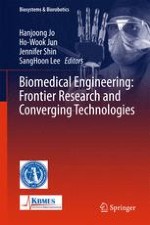2016 | OriginalPaper | Buchkapitel
Hemodynamics and Mechanobiology of Aortic Valve Calcification
verfasst von : Joan Fernandez Esmerats, Jack Heath, Amir Rezvan, Hanjoong Jo
Erschienen in: Biomedical Engineering: Frontier Research and Converging Technologies
Aktivieren Sie unsere intelligente Suche, um passende Fachinhalte oder Patente zu finden.
Wählen Sie Textabschnitte aus um mit Künstlicher Intelligenz passenden Patente zu finden. powered by
Markieren Sie Textabschnitte, um KI-gestützt weitere passende Inhalte zu finden. powered by
Calcific aortic valve disease (CAVD) is a significant cause of mortality among the aging population. Because disease mechanisms are still unclear, the only current treatment option for this disease is aortic valve replacement. In order to understand the disease and develop treatment targets, we must explore the hemodynamic and mechanical forces affecting the valve, as well as the biological pathways altered by those mechanics ultimately leading to tissue calcification. The unique structure of the valve allows it to adapt to the constantly changing mechanical environment and the wide array of forces exerted upon the tissue during the cardiac cycle. CAVD results in an impairment in the structure and function of the aortic valve, resulting in pathological systemic changes. A variety of mechanosensors at the valvular endothelial cell surface are responsible for transmission of mechanical signals to alter cell phenotype and ultimate tissue function. Recently, valvular microRNAs have been discovered to be mechanosensitive, possibly regulating key signaling in the pathology of CAVD. Our understanding of the aortic valve and CAVD is evolving rapidly, and future therapies rely on further exploration of this complex disease.
The aortic valve regulates the flow between the left ventricle and the aorta (Figure 1A) supplying oxygenated blood to the body. It opens during systole as the ventricle contracts, forwarding blood to the circulatory system, and closes as the ventricle relaxes—due to the beating of the heart known as the cardiac cycle. Calcific aortic valve disease encompasses a number of clinical conditions ranging from hardening and thickening of the aortic valve (aortic valve sclerosis) to severe reduction of the aortic valve area (aortic valve stenosis), resulting in obstruction of the blood flowing from the left ventricle [
1
]. This disease causes more than 28,000 deaths a year and 48,000 hospitalizations in the United States. CAVD is present in 25-29% of the population over 65 and is associated with a 50% increase in myocardial infarction and cardiovascular death [
2
-
6
]. By the time it is clinically recognized the only available treatment is valve replacement or repair surgery [
7
]. Traditionally, open-heart surgery was required for valve replacement; however, new technologies have allowed for less invasive methods, such as transcatheter aortic valve implantation (TAVI) [
8
,
9
]. Of the 300,000 prosthetic valves implanted worldwide in 2010, a third (100,000) were in North America [
10
]; projections estimate that by 2050, 850,000 implants will occur per year [
11
].
CAVD is associated with subclinical inflammation, which leads to thickening of the valve and fibrosis and ends with calcium deposition within the valve [
12
]. The region of the valve that is preferentially calcified is the fibrosa, the side facing the aorta. This side of the valve experiences higher mechanical stimuli combined with lower magnitude oscillatory shear stress. Regions of the cardiovascular system exposed to these mechanical conditions are considered especially susceptible to inflammation leading to cardiovascular disease, including during atherosclerotic plaque development [
13
-
15
]. In fact, the role of shear stress in development of valvular dysfunction is clear when considering the individual valve leaflets and the flow experienced by each. The noncoronary cusp (NCC, Figure 1B) is subjected to a lower magnitude of shear stress than the other two leaflets due to the absence of diastolic coronary flow, and this leaflet is commonly the first to exhibit calcification [
16
].
Early inflammation in the aortic valve endothelium is believed to occur due to a wide range of events, usually as a consequence of valvular endothelial dysfunction due to pathological flow, chronic inflammatory disease, or other inflammatory conditions [
17
,
18
]. The thickening of the aortic valve follows the inflammatory phase and is due to lipoprotein accumulation, cellular infiltration and extracellular matrix (ECM) formation [
2
]. As a result of extensive endothelial inflammation in early stages of aortic valve calcification, T lymphocytes and monocytes infiltrate the tissue and are activated, releasing cytokines such at TGF-β1 or IL-1β [
19
-
21
]. These cytokines contribute in later stages of the disease by promoting ECM formation and remodeling, and at the later stages local calcification is observed as calcium phosphate crystals are deposited in the ECM (Figure 1C) [
22
,
23
]. Calcification of the aortic valve is the result of valvular interstitial cell (VIC) differentiation into osteoblasts, characterized by an upregulation of bone-related intermediates and transcription factors, including bone morphogenetic proteins, transforming growth factor β1, osteopontin, bone sialoprotein, osteocalcin, alkaline phosphatase and Runx2 [
24
].
In order to understand the mechanisms leading to CAVD, this chapter explores the mechanical and biological aspects of the valvular environment. First, a general overview of the valve structure, including the crucial extracellular components, gives a picture of the complex construction allowing for the tissue’s physiological function. The following discussion explores the biomechanical forces exerted on the valve, giving insight into new tissue engineering approaches useful for studying CAVD. Finally, a thorough examination of the biological pathways involved in initiation of the pathological disease, with a focus on the mechanosensory mechanisms within the endothelium, links the mechanical forces in the tissue environment to the resulting pathological inflammation and ultimate valve calcification.
